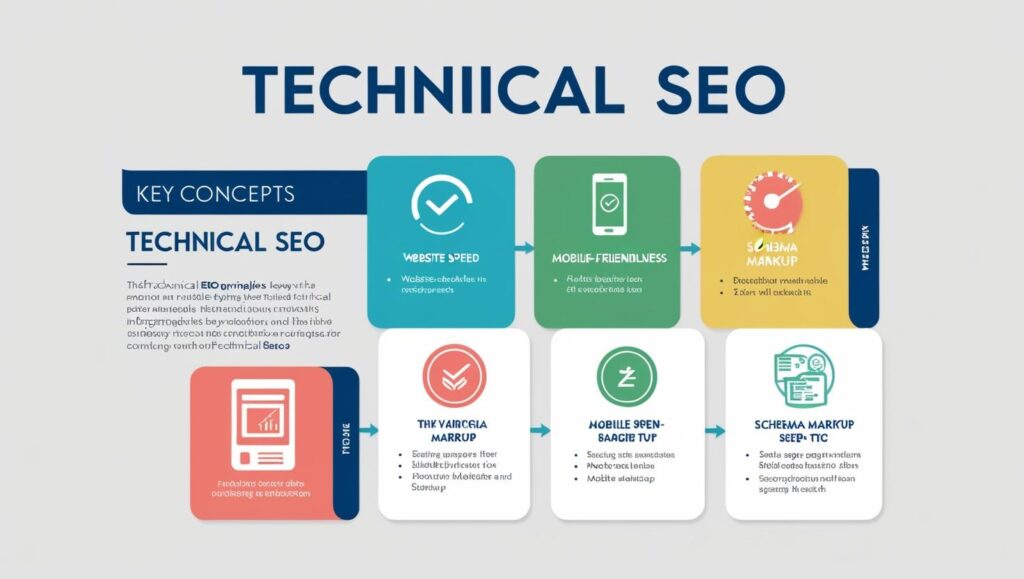Welcome to the definitive guide to Technical SEO for 2025! In the ever-evolving landscape of search engine optimization, mastering the technical aspects of your website is no longer optional – it’s fundamental for achieving and maintaining top rankings. This comprehensive guide will walk you through the crucial elements of technical SEO, ensuring your site is not only user-friendly but also perfectly crawlable and indexable by search engines like Google.
What is Technical SEO?
At its core, technical SEO focuses on optimizing the underlying infrastructure of your website to help search engines find, understand, and index your content effectively. Unlike on-page SEO (which deals with content optimization) and off-page SEO (which focuses on link building and brand mentions), technical SEO addresses the site’s architecture and technical setup. Think of it as laying a solid foundation upon which your content and off-page efforts can thrive.
Why is Technical SEO Crucial in 2025?
In 2025, several factors make technical SEO more important than ever:
- Algorithm Sophistication: Search engine algorithms are becoming increasingly sophisticated, placing a greater emphasis on website quality, user experience, and technical soundness.
- Mobile-First Indexing: Google predominantly crawls and indexes the mobile version of websites. A technically sound mobile site is no longer a luxury but a necessity.
- Core Web Vitals: These metrics, focusing on speed, interactivity, and visual stability, directly impact your rankings. Optimizing for them is a key technical SEO task.
- Voice Search and Structured Data: As voice search adoption grows, properly implemented structured data helps search engines understand your content better, making it eligible for rich snippets and voice answers.
- Site Speed Expectations: Users expect lightning-fast loading times. Slow websites lead to high bounce rates and poor user experience, negatively impacting rankings.
Key Areas of Technical SEO in 2025:
Let’s dive into the critical areas you need to focus on for technical SEO success in 2025:
1. Website Architecture and Crawlability:
- Clear Site Structure: Organize your website logically with a clear hierarchy. This helps search engine crawlers understand the importance of different pages and improves user navigation. Aim for a shallow site structure where important pages are accessible within a few clicks from the homepage.
- Example:
homepage > category page > sub-category page > product page.
- Example:
- Internal Linking: Strategically link relevant pages within your website. This distributes link equity, improves crawlability, and helps users discover related content.
- Tip: Use descriptive anchor text for your internal links.
- XML Sitemap: An XML sitemap lists all the important URLs on your website, helping search engines discover and index them efficiently. Ensure your sitemap is up-to-date and submitted to search engine consoles (Google Search Console and Bing Webmaster Tools).
- Robots.txt: This file instructs search engine crawlers which pages or sections of your website they should not access. Use it carefully to prevent crawling of irrelevant or duplicate content.
- HTTPS Implementation: Ensure your website is secure with HTTPS. It’s a ranking factor and crucial for user trust and data security.
- Canonical Tags: Use canonical tags (
rel="canonical") to specify the preferred version of a page when you have duplicate or very similar content. This prevents search engines from penalizing your site for duplicate content.
2. Mobile-Friendliness and Responsiveness:
- Mobile-First Design: Design your website primarily for mobile devices. Ensure it’s responsive and adapts seamlessly to different screen sizes.
- Mobile Page Speed: Optimize your mobile site for speed. Use tools like Google PageSpeed Insights to identify and fix issues that slow down your mobile pages.
- Mobile Usability: Ensure your mobile site is easy to navigate and use on smaller screens. Pay attention to factors like font size, button placement, and touch targets.
3. Website Speed and Performance:
- Core Web Vitals Optimization: Focus on improving your Largest Contentful Paint (LCP), First Input Delay (FID), and Cumulative Layout Shift (CLS) scores. These metrics directly impact user experience and SEO.
- LCP: Measures how long it takes for the largest element on the page to become visible. Aim for under 2.5 seconds.
- FID: Measures the time from when a user first interacts with your site (e.g., clicks a button) to the time when the browser actually responds to that interaction. Aim for under 100 milliseconds.
- CLS: Measures the amount of unexpected layout shift of visible page content. Aim for a score of less than 0.1.
- Image Optimization: Compress images without sacrificing quality to reduce file sizes and improve loading times. Use modern image formats like WebP where supported.
- Caching: Implement browser caching and server-side caching to store static files and serve them faster to returning visitors.
- Content Delivery Network (CDN): Use a CDN to distribute your website’s files across multiple servers geographically closer to your users, reducing latency and improving loading speed.
- Minify CSS, JavaScript, and HTML: Remove unnecessary characters (whitespace, comments) from your code to reduce file sizes.
4. Structured Data Markup:
- Schema.org Vocabulary: Implement structured data markup using Schema.org vocabulary to help search engines understand the context and meaning of your content.
- Rich Snippets: Properly implemented structured data can lead to rich snippets in search results, making your listings more eye-catching and increasing click-through rates.
- Examples: Product reviews, event listings, FAQ snippets, recipe details.
- Voice Search Optimization: Structured data can also help your content be eligible for voice search answers.
5. Indexing and Crawl Control:
- Monitor Crawl Errors: Regularly check your Google Search Console and Bing Webmaster Tools for crawl errors and fix them promptly.
- Noindex Tag: Use the
noindexmeta tag to prevent specific pages from being indexed by search engines (e.g., thank you pages, internal search results). - Nofollow Attribute: Use the
nofollowattribute for outbound links to websites you don’t want to associate your site with or for user-generated content. - Pagination: Implement proper pagination markup (
rel="next"andrel="prev") for paginated content to help search engines understand the relationship between pages.
6. International SEO (if applicable):
- Hreflang Tags: If you have a multilingual website, use hreflang tags (
rel="alternate" hreflang="x") to tell search engines which language and regional version of a page to display to users based on their location and language preferences. - Country-Specific Domains (ccTLDs): Using country-code top-level domains (e.g.,
.defor Germany,.frfor France) can signal to search engines that your content is specifically targeted to users in those regions. - Subdirectories or Subdomains: You can also use subdirectories (e.g.,
example.com/de/) or subdomains (e.g.,de.example.com) to structure your multilingual content.
7. Security:
- Regular Security Audits: Conduct regular security audits to identify and address potential vulnerabilities.
- Malware Scanning and Removal: Implement measures to protect your site from malware and promptly remove any infections.
- Strong Passwords and User Permissions: Enforce strong password policies and manage user permissions carefully.
Staying Ahead in 2025:
Technical SEO is an ongoing process. To stay ahead in 2025, you need to:
- Keep Up with Algorithm Updates: Stay informed about the latest changes and updates from search engines.
- Monitor Website Performance Regularly: Continuously monitor your website’s performance metrics and make adjustments as needed.
- Utilize SEO Tools: Leverage tools like Google Search Console, Bing Webmaster Tools, Google Analytics, and various SEO audit tools to identify and address technical issues.
- Prioritize User Experience: Remember that technical SEO ultimately serves the goal of providing a positive user experience. A technically sound website is more likely to engage and retain visitors.
Conclusion:
Mastering technical SEO is a critical investment for long-term success in 2025. By focusing on website architecture, mobile-friendliness, speed, structured data, and other technical elements, you can ensure that search engines can effectively crawl, index, and understand your content, ultimately leading to improved visibility, traffic, and conversions. This ultimate guide provides a solid foundation for your technical SEO efforts. Implement these strategies diligently, stay updated with the latest trends, and watch your website thrive in the competitive online landscape.


